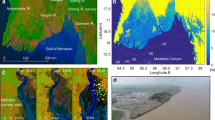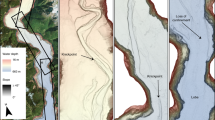Abstract
In meandering rivers, bend cutoffs have long been recognized as an important mechanism of change in the path of the channel. Meander bend cutoffs can develop by the progressive migration of an elongated bend onto itself, which forms a neck cutoff, or by the erosion of a new channel across the neck of the bend, which is known as a chute cutoff1. River cutoffs affect channel navigation2, and form meander scars and oxbow lakes in river floodplains1,3,4, which are important habitats for riparian ecosystems5. The importance of cutoff processes in meander dynamics is well established1,3,4,6,7,8, but the effects of cutoffs on overall sediment flux are poorly characterized. Here we use aerial imagery, global positioning system mapping and measurements of channel bathymetry to estimate the amount of sediment released by two chute cutoffs on the Wabash River in the Midwestern USA. We find that each event triggered the rapid delivery of sediment into the river, at rates that are one to five orders of magnitude larger than those produced by lateral migration of individual bends. We find that much of this material was deposited immediately downstream, at the confluence of the Wabash and Ohio rivers, which led to significant changes in channel morphology. This sedimentation ultimately impeded barge traffic and necessitated extensive dredging.
This is a preview of subscription content, access via your institution
Access options
Subscribe to this journal
Receive 12 print issues and online access
$259.00 per year
only $21.58 per issue
Buy this article
- Purchase on Springer Link
- Instant access to full article PDF
Prices may be subject to local taxes which are calculated during checkout



Similar content being viewed by others
References
Lewis, G. W. & Lewin, J. in Modern and Ancient Fluvial Systems (eds Collinson, J. D. & Lewin, J.) 145–154 (International Association of Sedimentologists Series, Special Publication 6, Blackwell, 1983).
Twain, M. Life on the Mississippi (Signet Classics, 1961).
Allen, J. R. L. A review of the origin and characteristics of recent alluvial sediments. Sedimentology 5, 89–191 (1965).
Constantine, J. A. & Dunne, T. Meander cutoff and the controls on the production of oxbow lakes. Geology 36, 23–26 (2008).
Amoros, C. The concept of habitat diversity between and within ecosystems applied to river side-arm restoration. Environ. Manage. 28, 805–817 (2001).
Constantine, J. A., McLean, S. R. & Dunne, T. A mechanism of chute cutoff along large meandering rivers with uniform floodplain topography. Geol. Soc. Am. Bull. 122, 855–869 (2010).
Gay, G. R. et al. Evolution of cutoffs across meander necks in Powder River, Montana, USA. Earth Surf. Process. Landf. 23, 651–662 (1998).
Hickin, E. J. & Nanson, G. C. The character of channel migration on the Beatton River, northeast British Colombia, Canada. Geol. Soc. Am. Bull. 86, 487–494 (1975).
Wolman, M. G. & Gerson, R. Relative scales of time and effectiveness of climate in watershed geomorphology. Earth Surface Process. 3, 189–208 (1978).
Howard, A. D. in Lowland Floodplain Rivers (eds Carling, P. A. & Petts, G. E.) 1–42 (Wiley, 1992).
Peakall, J., Ashworth, P. J. & Best, J. L. Meander-bend evolution, alluvial architecture, and the role of cohesion in sinuous river channels: A flume study. J. Sedim. Res. 77, 197–212 (2007).
Constantine, J. A., Dunne, T., Piégay, H. & Kondolf, G. M. Controls on the alluviation of oxbow lakes by bed-material load along the Sacramento River, California. Sedimentology 57, 389–407 (2010).
Erskine, W., McFadden, C. & Bishop, P. Alluvial cutoffs as indicators of former channel conditions. Earth Surf. Process. Landf. 17, 23–37 (1992).
Gagliano, S. M. & Howard, P. C. River Meandering, Proceedings of the Conference Rivers ’83 147–158 (American Society of Civil Engineers, 1984).
Hooke, J. M. River channel adjustment to meander cutoffs on the River Bollin and River Dane, northwest England. Geomorphology 14, 235–253 (1995).
Lauer, J. W. & Parker, G. Net local removal of floodplain sediment by river meander migration. Geomorphology 96, 123–149 (2008).
Fuller, I. C., Large, A. R. G. & Milan, D. J. Quantifying channel development and sediment transfer following chute cutoff in a wandering gravel-bed river. Geomorphology 54, 307–323 (2003).
Soil Survey Staff, Natural Resources Conservation Service, United States Department of Agriculture. Official Soil Series Descriptions (USDANRCS, 2010); available at http://soils.usda.gov/technical/classification/osd/index.html.
Kim, W., Mohrig, D., Twilley, R., Paola, C. & Parker, G. Is it feasible to build new land in the Mississippi River delta? Eos Trans. AGU 90, 373–374 (2009).
Micheli, E. R. & Larsen, E. W. River channel cutoff dynamics, Sacramento River, California, USA. Riv. Res. Appl. 27, 328–344 (2011).
Acknowledgements
This research was supported by a NSF SGER Grant (BCS-0852865). We thank K. Collier, B. Norfleet, and B. Floyd for access to the field site and for the eyewitness accounts of cutoff channel formation and the development of gullies across the interior of Mackey Bend caused by overbank flows in June 2008. We thank S. Riche of the Indianapolis Star for the oblique aerial photograph. Information regarding data for river dredging was obtained from Mr B. Vessels, Louisville District of the US Army Corps of Engineers. We also thank K. Johnson, F. Engel, J. Riley, and K. Konsoer for assistance with field data collection and R. Jackson for discussions on Wabash River morphodynamics.
Author information
Authors and Affiliations
Contributions
All authors gathered field data, and J.A.Z. processed the field data. All authors performed analysis and interpretation, and contributed to writing of the manuscript at all stages.
Corresponding author
Ethics declarations
Competing interests
The authors declare no competing financial interests.
Supplementary information
Supplementary Information
Supplementary Information (PDF 922 kb)
Supplementary Movies
Supplementary Movies (AVI 3645 kb)
Supplementary Movies
Supplementary Movies (WMV 22506 kb)
Rights and permissions
About this article
Cite this article
Zinger, J., Rhoads, B. & Best, J. Extreme sediment pulses generated by bend cutoffs along a large meandering river. Nature Geosci 4, 675–678 (2011). https://doi.org/10.1038/ngeo1260
Received:
Accepted:
Published:
Issue Date:
DOI: https://doi.org/10.1038/ngeo1260
This article is cited by
-
Flow structure and channel morphology after artificial chute cutoff at the meandering river in the upper Yellow River
Arabian Journal of Geosciences (2022)
-
Impact of an artificial chute cutoff on the river morphology and flow structure in Sipaikou area of the Upper Yellow River
Journal of Mountain Science (2021)
-
Development of meander cutoffs—a multi-temporal satellite-based observation in parts of Sindh River, Madhya Pradesh, India
Arabian Journal of Geosciences (2015)



